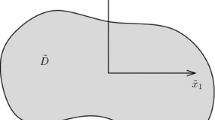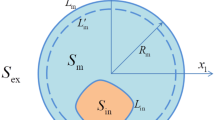Abstract
The stress and displacement fields due to an eigenstrain outside of an ellipsoid are analyzed both inside and outside the ellipsoid and are given in terms of nonsingular surface integrals. Constant and inverse power eigenstrains are discussed as examples.
Phase transformation strains, plastic strains, thermal strains, stress-free strains, and other inelastic strains are collectively labeled eigenstrains because the mathematical analysis generated from elasticity theory can, to a large extent, be determined independently of the physical source of the strain. The eigenstrain when added to the elastic strain gives the total strain. The stress field corresponding to this eigenstrain is called an eigenstress.
In this paper we will assume that the eigenstrain is zero inside an ellipsoid Ω and generally nonzero outside the ellipsoid in D-Ω where D denotes the whole body. We will assume D to be a three-dimensional, infinitely extended, anisotropic material. The stress and displacement fields will be found in terms of surface integrals. These can be analyzed exactly for some simple cases and numerically on a computer for more complex cases.
Many authors have studied eigenstrains when they are nonzero inside Ω. Eshelby [1] solved the case where the eigenstrain is a constant and discussed the problem of an ellipsoidal inhomogeneity in an isotropic material subjected to constant stresses. This was done by using an eigenstrain to simulate the effect of the inhomogeneity. This solution has been generalized to solve problems involving anisotropic materials by Kinoshita and Mura [2], polynomial eigenstrains by Asaro and Barnett [3] and periodic eigenstrains by Mura, Mori and Kato [4]. Many interesting solutions have been found, including ones for the two inclusion problem, martensitic transformation, and thermal inclusions among others (see [4]-[7]). Mura and Cheng [8] found a general solution when the eigenstrain is defined inside Ω. In this paper we will examine the case where the eigenstrain is defined in D-Ω and zero inside Ω. Nobody appears to have published solutions for this case before in spite of the fact that it leads to some exact solutions. Solutions of this kind should be useful in solving problems dealing with plastic fields located outside an ellipsoid, precipitate formation, and multiple inclusion problems among others. We will specifically examine the case where the eigenstrain is (1) constant and (2) of the form % MathType!MTEF!2!1!+-% feaafiart1ev1aaatCvAUfeBSjuyZL2yd9gzLbvyNv2CaerbuLwBLn% hiov2DGi1BTfMBaeXafv3ySLgzGmvETj2BSbqef0uAJj3BZ9Mz0bYu% H52CGmvzYLMzaerbd9wDYLwzYbItLDharqqr1ngBPrgifHhDYfgasa% acOqpw0xe9v8qqaqFD0xXdHaVhbbf9v8qqaqFr0xc9pk0xbba9q8Wq% Ffea0-yr0RYxir-Jbba9q8aq0-yq-He9q8qqQ8frFve9Fve9Ff0dme% GabaqaaiGacaGaamqadaabaeaafiaakeaacqaHYoGyliaabMgacaqG% QbGccaqGHbWaaWbaaSqabeaacaqGqbaaaOGaaiikaiaabIhajaaifa% qabeGabaaabaGaaiOmaaqaaiaacgdaaaGaey4kaSIccaqG4bqcaasb% aeqabiqaaaqaaiaackdaaeaacaGGYaaaaiabgUcaROGaaeiEaKaaGu% aabeqaceaaaeaacaGGYaaabaGaai4maaaakiaacMcadaahaaWcbeqa% aiabgkHiTiaadchacaGGVaGaaiOmaaaaaaa!57D6!\[\beta {\text{ija}}^{\text{P}} ({\text{x}}\begin{array}{*{20}c}2 \\1 \\\end{array} + {\text{x}}\begin{array}{*{20}c}2 \\2 \\\end{array} + {\text{x}}\begin{array}{*{20}c}2 \\3 \\\end{array} )^{ - p/2}\]where p > 0, Ω is a sphere of radius a, β ij are constants, and the material is isotropic.
Similar content being viewed by others
References
J.D. Eshelby, The determination of the elastic field of an ellipsoidal inclusion, and related problems, Proc. Roy. Soc. A241 (1957) 376–396.
N. Kinoshita and T. Mura, Elastic fields of inclusions in anisotropic media, Phys. Stat. Sol. (A), 5 (1971) 759–768.
R.J. Asaro and D.M. Barnett, The non-uniform transformation strain problem for an anisotropic ellipsoidal inclusion, J. Mech. Phys. Solids, 23 (1975) 77–83.
T. Mura, T. Mori and M. Kato, The elastic field caused by a general ellipsoidal inclusion and the application to martensite formation, J. Mech. Phys. Solids, 24 (1976) 305–318.
T. Mura, Micromechanics of Defects in Solids, Martinus Nijhoff Publishers, The Hague (1982).
J.N. Goodier, On the integration of thermal elastic equations, Phil. Mag. (1937) 1017–1032.
T. Mori, P.C. Cheng, M. kato and T. Mura, Elastic strain energies of precipitates and periodically distributed inclusions in anisotropic media, Act. Metall. 26 (1978) 1435–1441.
T. Mura and P.C. Cheng, The elastic field outside an ellipsoidal inclusion, J. Appl. Mech. 44 (1977) 591–594.
L.J. Walpole, The elastic field of an inclusion in an anisotropic medium, Proc. Roy. Soc. London, Series A, Vol. 300 (1967) 270–289.
R. Hill, Discontinuity relations in mechanics of solids, in Prog. Sol. Mech., I.N. Sneddon and R. Hill (eds.), Vol. 2 (1961) 245–276.
S. Timoshenko and J.N. Goodier, Theory of Elasticity, McGraw-Hill (1970).
Author information
Authors and Affiliations
Additional information
This research was supported by US Army Research Grant DAAG29-81-K-0090.
Rights and permissions
About this article
Cite this article
Castles, R.R., Mura, T. The analysis of eigenstrains outside of an ellipsoidal inclusion. J Elasticity 15, 27–34 (1985). https://doi.org/10.1007/BF00041301
Received:
Issue Date:
DOI: https://doi.org/10.1007/BF00041301




